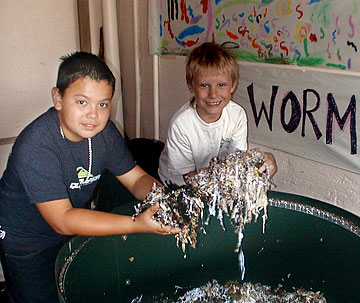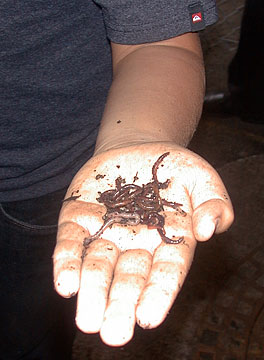© 1996-2006 The Honolulu Star-Bulletin | http://www.starbulletin.com/
"They're slimy and gross. They get all over you once they get on you."

|
The Wormy Way
Hilo charter school students learn how to get rid of lunch leftovers with some wormy friends
HILO » Connections charter school sixth-grader Shane Paredes doesn't like worms.
"They're slimy and gross. They get all over you once they get on you," he said.
But he happily grabs a handful of them from the school's new compost bin when it means he might get his picture in the paper.
Students, teachers and administrators at Connections in downtown Hilo just started warming up to worms this spring.
The school is the first in the state to have a full-scale composting operation based on a showy, 2-inch-long creature called the India blue worm, Principal John Thatcher said.
The tropical worm found throughout South Asia is reddish at first glance but has a glistening blue sheen when seen in bright light.

|
Owner of Hawaii Rainbow Worms, Selden has been teaching about worms and setting up small and large composting systems for three years. Last year, she set up an installation to compost manure at Island Dairy on the Hamakua Coast. She visited India to study worm composting.
Meanwhile, Connections had a problem like all schools: Kids eat only part of their lunch and throw the rest away. For Connections, that meant five trash bags per day full of garbage and dirty paper plates.
Some schools could give their garbage to pig farmers in the past, but as residential areas press up against farms, homeowners demand that the stinky farms go, Selden said.
So Selden taught Connections to plunk its garbage into two 3-foot-high, 3-foot-wide plastic bins with shredded paper and worms in them. The worms went to work eating both garbage and paper plates while making absolutely no smell.
Smell is caused by bacteria, Selden explained. Worms digest them.
At the bottom of each bin, a crank releases worm castings, useful as fertilizer. If school vacation comes along and someone forgets the worms, they just get sleepy and go dormant, Selden said.
Earthworms, the bigger cousins of the India blues, have long been an optional part of the public school curriculum, Thatcher said.
Connections sixth-graders now plan missions to Mars with the assignment to create human colonies on the red planet, Thatcher said. They learn that a good human colony includes a good worm colony.
Besides cleaning up human garbage on Mars, they could also -- hold onto your stomach -- serve as a high-protein food source, Thatcher said.
The reaction from sixth-grader Shane, who called worms "gross"?
"I would consider eating them if I had to," he said.
© 1996-2006 The Honolulu Star-Bulletin | http://www.starbulletin.com/
